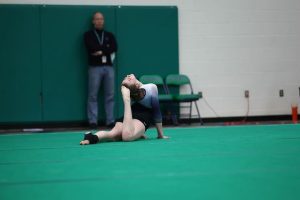
Opinions raged forward like water exploding out of a dam the moment the world-renowned professional gymnast Simone Biles announced her decision to leave the 2020 Tokyo Olympics. Expectantly, fans and spectators around the globe awaited her performance in Japan, but Biles decided it was not in her best interest to stay. What could cause an athlete to give up on the sport that cost them so many sacrifices? As the most decorated gymnast in Olympic history, Biles tried to push through mental turmoil that was holding her back. She ultimately decided to remove herself from the global competition due to a dangerous condition known as “the twisties,” where an athlete loses the sense of where they are in the air. Even on the Olympic stage, with the whole world watching, gymnastics can cause a breaking point. There is no exception to the mental and physical challenges of gymnastics in the high school world either.

Sophomore Woodgrove gymnast Hadley Ayotte voiced her view on the struggles that she has endured throughout her gymnastics career. As a gymnast of nine years, Ayotte described, “I have always had mental blocks. Most recently, I developed a mental block for my vault routine that led me to states, and not being able to throw it was very degrading and caused me to burn out.” The mental aspect of gymnastics contributes to the overall danger of the sport. “When your mind and your body can not connect for a skill, it is impossible to throw it,” Ayotte commented. Senior Woodgrove gymnast Jadyn Thomas shared her inspiring story of how she has stuck with gymnastics for nine years, despite the grueling two to three year span where she had to wait out an injury. At eight years old, Thomas suffered an elbow injury that limited her to doing conditioning at her four and a half hour practices instead of getting to do gymnastics with the other athletes. Thomas offered insight on where she found the strength to not give up, explaining, “My motivation to stay was the hope that one day I would be healed, and it would be okay. I just loved the sport too much, so I stayed and hoped for the day that I would be better.” Thomas is another gymnast who has experienced her fair share of mental blocks. She shared her perspective on the challenge, saying, “I don’t think mental blocks get easier, but I have learned ways to work through them over the years. Having my coach stand there next to me helps, just knowing that she’ll be there if anything goes wrong. On beam, I take a couple deep breaths and count down from three, and on one I’ll just make myself go.”

Although it is a common struggle, mental blocks are not experienced by every gymnast. Sophomore Addison Clarke, who is a former Woodgrove gymnast, described herself as someone who was free from mental blocks, but faced challenges in other forms. “It was cool to learn how to move my body and control it in ways I couldn’t otherwise do. I wasn’t scared to do what my coach asked, so I was able to catch onto it pretty quickly,” Clarke explained. Instead, she faced the pressures to advance and perform their skills perfectly. “It hit me hard when I was not performing to my standards. Gymnastics was something that I used to have that confidence of ‘I can control something and I am good at something,’ because I could not do that in my personal life,” Clarke reflected.

The mental strain from the dangers of gymnastics can transfer to the hearts and minds of loved ones as well. Athlete Hadley Ayotte’s mother, Bree Ayotte, shared her experience of having a child involved in the sport of gymnastics, saying, “I try not to think about it. We’ve experienced a range of injuries, but she always puts in the work and bounces back.” She continued, “It is nerve racking, but I trust her, and I’m always proud.”
A gymnasts’ ability to bounce back and keep pushing demonstrates the resilience and determination needed for the sport. In the words of Clarke, “Gymnastics is very much a sport where you tape it up and keep going.” The dangers of gymnastics will always be present, but the love for the sport and the trust athletes gain in their families, coaches, and ultimately themselves, is what keeps the spark alive.



